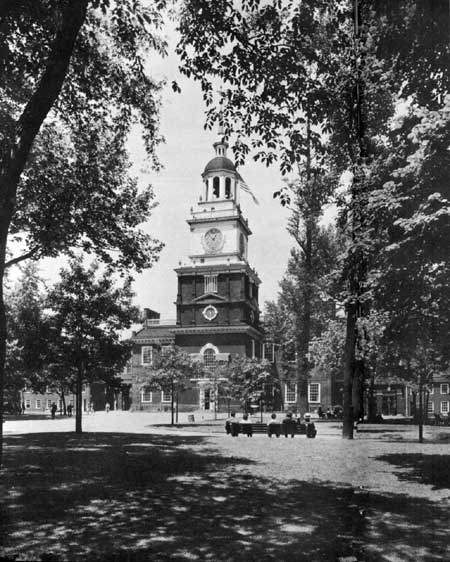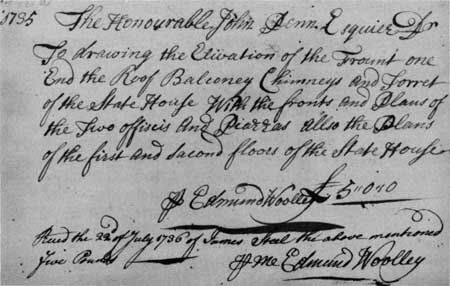|
INDEPENDENCE National Historical Park |
 |

Independence Hall,
Photo by R. G. Madill.
"THE UNITED STATES was created in Philadelphia on July 4, 1776, when the Continental Congress voted the final form of the Declaration of Independence. The United States was perpetuated on September 17, 1787, when the Federal Convention completed its work on the Constitution and referred it, through Congress, to the individual states for ratification. Both these great decisions were made in the same chamber in what is now called Independence Hall, but was then the Pennsylvania State House. it would still be merely the old State House if independence had not been achieved and if the Constitution had not been ratified and put into effect. The noble building, so venerable to later ages, might not even have survived, but might have been swept away in the surging growth of a modern city. in that case, a few students of history would sometimes remember the site as the stage of those lost causes. instead, Pennsylvania's State House has become Independence Hall for the entire United States. Nor is that all. On account of the Declaration of Independence, it is a shrine honored wherever the rights of men are honored. On account of the Constitution, it is a shrine cherished wherever the principles of self-government on a federal scale are cherished."—CARL VAN DOREN.

Account of Edmund Woolley with Governor John Penn for floor plans
and elevation drawings of the State House, 1735—36.
Penn Manuscripts, Historical Society of Pennsylvania
The Provincial State House
Independence Hall was originally the State House of Pennsylvania. For a half century after the establishment of the Province, the government had no official building. The Assembly, a small legislative body, was compelled to meet in private dwellings rented annually for the purpose or in the old City Hall at Second and High (now Market) Streets.
In order to meet the needs of the Province, funds were appropriated for the construction of the State House in 1729. At the same time a committee, consisting of Speaker of the Assembly Andrew Hamilton, Assemblyman Dr. John Kearsley, and Councilman Thomas Lawrence, was named to supervise the job. Strong disagreement arose between Hamilton and Kearsley, with each supporting a different location and plan. This disagreement delayed actually beginning work on the building until 1732. In that year the Assembly approved the plan Hamilton advocated and selected the south side of Chestnut Street between Fifth and Sixth Streets as the site. This was then on the outskirts of the city.
In the 1730's, Philadelphia had a population of almost 11,500 people. Only Boston, with 13,000, was larger; while New York was third, with 8,500. The area of what was to become Independence Square contained only a few small houses. The uneven ground was covered on the north with whortleberry bushes; to the south, across Walnut Street, stood a peach orchard.
It is apparent that the plans from which the State House was constructed were drawn by Edmund Woolley, master carpenter, who was also the principal builder under the direction of Andrew Hamilton. To these two men go the major credit for the design and erection of one of the most beautiful administrative buildings of the Colonial period.
Building the State House was a slow process. The Assembly was not able to meet in the new building until September 1735. Even at that time the walls had not been paneled, nor had all of the window panes been installed. Difficulties of various kinds, especially the scarcity of skilled workmen, kept the building in an unfinished state. Finally, in the summer of 1741, the impatient Assembly ordered that the walls and windows of their chamber be finished at once and the remainder of the building completed without undue delay. Despite this order, plans for completing the Supreme Court chamber were not submitted until November 1743. The Council Chamber on the upper floor was not ready for occupancy until February 1748. It appears probable that the building was completed about this date.
During construction of the State House the old custom of "raising feasts" was followed. When the main timbers in a building were raised, a sumptuous feast was given for the workmen in celebration of the event. As the building of the State House progressed, there were a number of such feasts, the cost of them borne by the Provincial government.
Shortly after the construction of the State House was started, the Assembly ordered that office buildings be erected as wings to the main building, for the safekeeping of the public papers of the Province. Early in 1736 the wings on each side of the State House were practically completed, but public officials objected strenuously to moving into them. Despite objections, however, it is obvious that the wings were soon occupied by various county and provincial officials. Others also used these small buildings, for in 1739 the Library Company of Philadelphia was granted permission to deposit its books in the upper floor of the west wing. The Library remained there until 1773 when it was moved to Carpenters' Hall. Throughout the Colonial period the doorkeeper of the Assembly and his family also lived in the west wing. Furthermore, during the early years, Indian delegations visiting Philadelphia were sometimes lodged in one of the wings.
These exotic tenants proved a source of worry to the Assembly. Their carelessness with fire posed such a serious threat to public records that, in 1759, the Assembly ordered the erection of a separate building for the use of the Indians. It is thought that one of the two wooden sheds built before the Revolution at the corners of Fifth and Sixth Streets on Chestnut Street was used for this purpose.

Very early floor plan of the State House (first
floor above, second floor right), apparently drawn prior to erection of
tower, showing the interior stairway in south end of hallway.
In
Penn Manuscripts, Warrants and surveys, Historical Society of
Pennsylvania.
Although the 15 years required to build the State House must have been a source of irritation to legislators eager to occupy it, the completed building proved the time was well spent. A most ambitious project for that early date, it emerged a sturdily constructed brick edifice—described at the time as a "large handsome building"—with a facade 107 feet in length connected by closed arcades, or "piazzas," to wing buildings some 50 feet long. The main building had a decked gable roof, balustraded between the chimneys and surmounted by a centrally located cupola. The interior arrangement of the State House provided suitable space for the various agencies of government. The first floor contained two chambers about 40 feet square, separated by a spacious center hall about 20 feet wide. The eastern chamber served as the meeting place of the Assembly. This room, in the words of a contemporary in 1774, was "finished in a neat but not elegant manner." Since the Assembly's sessions were usually secret, the room was provided with a door. The western chamber housed the Supreme Court of the Province and was entered through open archways. The staircase to the upper floor occupied the south end of the central hall. The Provincial Council, the Governor's advisory body, met in a chamber approximately 20 by 40 feet in the southwestern corner of the upper floor. This room was separated by a small vestibule from a chamber in the southeast corner which was designed as a committee room of the Assembly. The entire Chestnut Street frontage was one room, called the "gallery," or "long room," measuring 100 by 20 feet. The gallery was used generally for public entertainment and banquets.
It is apparent that the State House was not elegantly furnished. Chairs, tables, curtains, screens, and other items purchased for the building were never unduly expensive. However, the silver ink stand, purchased from Philip Syng, of Philadelphia, for the table of the Speaker of the Assembly, and still preserved in Independence Hall, was a most unusual item which cost £25—167#151;0. The building appears to have been heated originally by open fireplaces for which stoves were later substituted. Lighting was not a serious problem since the meetings rarely continued until darkness; when they did, the Assembly ordered that candles be brought in. There is no known picture of the interior of the State House during the Colonial period; the earliest representation is a painting of the Assembly Room attributed to Pine and Savage, "The Congress Voting Independence," which was executed about 1800.
In January 1750, shortly after the State House was completed, the Assembly authorized the superintendents of the building to erect a tower to contain a staircase and belfry. Edmund Woolley was entrusted with the construction. By 1753, the tower was completed and the State House bell (now called the Liberty Bell), ordered in 1751, was hung.
The Assembly also ordered a "large Clock to strike on the Bell." Subsequently, its works were installed in the attic of the State House, with clock faces in the end walls just below the eaves. Under the face of that clock in the west end, a masonry structure resembling a tall-case clock was constructed, the hands of both timepieces being moved by rods connected with the mechanism in the attic. The steeple bell, however, was not used to strike the hours. A second bell was ordered by the Assembly, in 1752, for that purpose and was placed in a turret on the main roof just before the tower.

|

| History | Links to the Past | National Park Service | Search | Contact |
|
Last Modified: Mon, Dec 2 2002 10:00:00 am PDT |

